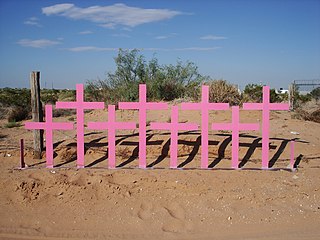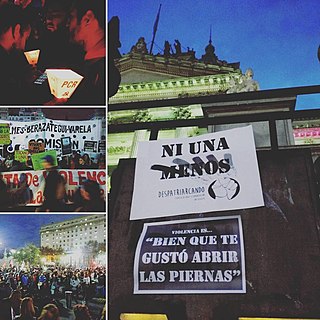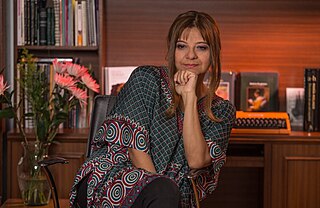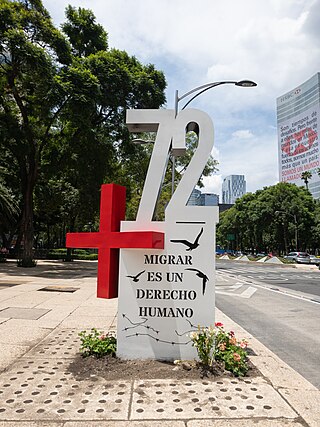
It was estimated that more than 370 women were killed between 1993 and 2005 in Ciudad Juárez, a city in northern Mexico. The murders of women and girls received international attention primarily due to perceived government inaction in preventing the violence and bringing perpetrators to justice. The issue has featured in many dramas, songs, books, and so on.
Feminism in Mexico is the philosophy and activity aimed at creating, defining, and protecting political, economic, cultural, and social equality in women's rights and opportunities for Mexican women. Rooted in liberal thought, the term feminism came into use in late nineteenth-century Mexico and in common parlance among elites in the early twentieth century. The history of feminism in Mexico can be divided chronologically into a number of periods with issues. For the conquest and colonial eras, some figures have been re-evaluated in the modern era and can be considered part of the history of feminism in Mexico. At the time of independence in the early nineteenth century, there were demands that women be defined as citizens. The late nineteenth century saw the explicit development of feminism as an ideology. Liberalism advocated secular education for both girls and boys as part of a modernizing project, and women entered the workforce as teachers. Those women were at the forefront of feminism, forming groups that critiqued existing treatment of women in the realms of legal status, access to education, and economic and political power. More scholarly attention is focused on the Revolutionary period (1915–1925), although women's citizenship and legal equality were not explicitly issues for which the revolution was fought. The Second Wave and the post-1990 period have also received considerable scholarly attention. Feminism has advocated for the equality of men and women, but middle-class women took the lead in the formation of feminist groups, the founding of journals to disseminate feminist thought, and other forms of activism. Working-class women in the modern era could advocate within their unions or political parties. The participants in the Mexico 68 clashes who went on to form that generation's feminist movement were predominantly students and educators. The advisers who established themselves within the unions after the 1985 earthquakes were educated women who understood the legal and political aspects of organized labor. What they realized was that to form a sustained movement and attract working-class women to what was a largely middle-class movement, they needed to utilize workers' expertise and knowledge of their jobs to meld a practical, working system. In the 1990s, women's rights in indigenous communities became an issue, particularly in the Zapatista uprising in Chiapas. Reproductive rights remain an ongoing issue, particularly since 1991, when the Catholic Church in Mexico was no longer constitutionally restricted from being involved in politics.
Violence against women in Mexico includes different forms of gender-based violence. It may consist of emotional, physical, sexual, and/or mental abuse. The United Nations (UN) has rated Mexico as one of the most violent countries for women in the world. According to the National Institute of Statistics and Geography in Mexico (INEGI), 66.1 percent of all women ages 15 and older have experienced some kind of violence in their lives. Forty-nine percent have suffered from emotional violence; 29 percent have suffered from emotional-patrimonial violence or discrimination; 34 percent from physical violence; and 41.3 percent of women have suffered from sexual violence. Of the women who were assaulted in some form from 2015 to 2018, 93.7 percent of them did not seek help or report their attacks to authorities.

Ni una menos is a Latin American fourth-wave grassroots feminist movement, which started in Argentina and has spread across several Latin American countries, that campaigns against gender-based violence. This mass mobilization comes as a response to various systemic issues that proliferate violence against women. In its official website, Ni una menos defines itself as a "collective scream against machista violence." The campaign was started by a collective of Argentine female artists, journalists and academics, and has grown into "a continental alliance of feminist forces". Social media was an essential factor in the propagation of the Ni Una Menos movement to other countries and regions. The movement regularly holds protests against femicides, but has also touched on topics such as gender roles, sexual harassment, gender pay gap, sexual objectification, legality of abortion, sex workers' rights and transgender rights.

#NiUnaMenos is a Peruvian group against femicides and violence against women in the Andean country. The movement was formed in July 2016, and the march it staged in August 2016 has been characterized as the largest demonstration in Peruvian history

Isabel Cabanillas de la Torre was a Mexican artist, and activist with Mesa de Mujeres. She was also a member of Hijas de su Maquilera Madre an anti-capitalist feminist collective from Ciudad Juárez, with which she protested against femicides in the city.
On 11 February 2020, Fátima Cecilia, a seven-year-old girl, disappeared, and four days later, on 15 February, was found dead in a garbage bag in a vacant lot in Tláhuac, Mexico City, Mexico with signs of physical violence and sexual abuse. The murder of Fátima has caused commotion in Mexico.

On 9 February 2020, Ingrid Escamilla Vargas was murdered by her partner, Erik Francisco Robledo Rosas, at her home in Mexico City after an argument. The act outraged the public opinion of Mexico for the brutality with which it was perpetrated and for the subsequent spreading of images of the victim's body in the media and on social media.

Isabel Agatón Santander is a Colombian poet, lawyer, writer and feminist. Promoter of the Rosa Elvira Cely Law which defines femicide as a crime in Colombia, she integrated the editorial commission of Law 1257 of 2008 about violence against women. She was a judge in the Tribunales de Conciencia de Justicia Para las Mujeres in Nicaragua (2015) and El Salvador in which they tried cases of sexual violence and femicide convened by the Red Feminista frente a la Violencia contra las Mujeres (REDFEM) and the Red contra Violencia of the respective countries.

Spain's National March in Opposition to Male Violence(s) Against Women, also known as 7N, was a mass citizen mobilisation, convened as a "feminist movement", which came to occupy the centre of Madrid on 7 November 2015. Organised by three hundred and thirty-two feminist organisations, it had the support of two hundred and twenty-two bodies, including political parties, unions and national and international feminist organisations, as well as one hundred and thirty-five district councils. The final event consisted in the reading of a manifesto compiling the condemnations and demands of the organisations involved, negotiated over nine months through working committees.

Vivir Quintana is a Mexican singer and composer. Quintana penned the song "Canción sin miedo", or Song without Fear, which has become a feminist hymn against gendered violence and femicide.
The Flora Tristán Peruvian Women's Center is a feminist non-governmental organization established in Lima in 1979 in defense of women's human rights and equality.

On the afternoon of 25 September 2021, a group of anonymous feminists intervened in the Christopher Columbus roundabout on Paseo de la Reforma Avenue, Mexico City. On an empty plinth surrounded by protective fences, they installed a wooden antimonumenta, a guerrilla sculpture that calls for justice for the recurrent acts of violence against women in Mexico. It was originally called Antimonumenta Vivas Nos Queremos, subsequently known as Justicia, and depicts a purple woman holding her left arm raised and the word justice carved into a support on the back. Additionally, the Columbus roundabout was also symbolically renamed the Glorieta de las mujeres que luchan.

The Young Woman of Amajac is a pre-Hispanic sculpture depicting an indigenous woman. It was discovered by farmers in January 2021 in the Huasteca region, in eastern Mexico.

An antimonumenta was installed in the Plaza de Armas, in Guadalajara, Jalisco on 25 November 2020, the date commemorating the International Day for the Elimination of Violence against Women, during the annual march of women protesting against gender violence. The sculpture is symbolically named Antimonumenta and it was inspired by the anti-monument of the same name placed in Mexico City a year prior.

In Mexico, anti-monuments are installed and traditionally placed during popular protests. They are installed to recall a tragic event or to maintain the claim for justice to which governments have failed to provide a satisfactory response in the eyes of the complainant.
An antimonumenta was installed next to the Fuente de las Tarascas, along Francisco I. Madero Avenue in Morelia, Michoacán, on 8 March 2021, the date commemorating International Women's Day, during the annual march of women protesting against gender violence. The sculpture, symbolically named Antimonumenta, was inspired by other similar anti-monuments like the one in Mexico City. The erection of an antimonumenta symbolizes the demand for justice for women who suffer from violence in the country.

Antimonumento +72 is an anti-monument located on the sidewalk opposite the Embassy of the United States in Mexico City, on Paseo de la Reforma in the borough of Cuauhtémoc. The work, made of steel, comprises a white number 72 and a red plus symbol, placed on a white pedestal with images of doves and the phrases "Migration is a human right" and "No one is illegal in the world" in Spanish. The sculpture was dedicated to the seventy-two migrants murdered in 2010 in the village of El Huizachal, in the municipality of San Fernando, Tamaulipas, after being detained by the drug cartel Los Zetas. The artwork was never given an official name; its installers referred to it simply as Antimonumento.
Richard Choque Flores is a Bolivian serial killer and rapist who killed at least two women in 2021, shortly after being released from a prior conviction. For the latter crimes, he was sentenced to 30 years imprisonment.

"Canción sin miedo" is a song of the regional Mexican genre by Mexican composer Vivir Quintana that speaks about the violence experienced by women, it has become an anthem in feminist protests.















